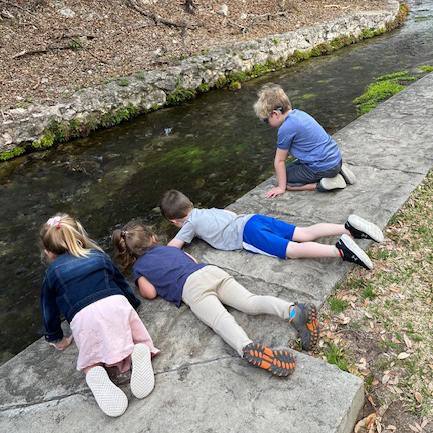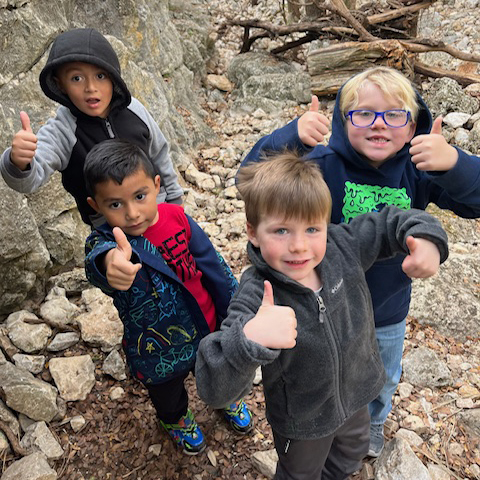Children in Nature:
Inspiring the Next Generation
The Importance of Connecting Children with Nature
Today children are more disconnected from the natural world than at any point in human history. The average American child spends approximately 7 minutes a day engaged in physical activity while they can spend over seven hours a day engaged in electronic media. This fundamental shift in childhood has made the process of growing up more difficult and has led to a variety of physical and mental issues across the country. Today more than 85% of Texans are growing up in urban areas and their understanding of the natural systems their communities require has been diminished as a result. Every time we connect a child with wonder of the natural world we help them in the immediate and we imbue in them a sense of appreciation for the out of doors.
Connecting children with nature is essential for their physical, mental, and emotional well-being. Research has shown that children who spend more time outside are Happier, Healthier, and Stronger. Time spent outdoors helps kids develop a sense of wonder and appreciation for the natural world, fosters creativity, and encourages physical activity. Nature experiences also enhance learning and problem-solving skills, promote environmental stewardship, and create lasting memories. These young people will become the next generation of environmental stewards. All of our conservation work will be for not, if we do not raise a new generation of Texans who care for these natural resources as much as we do.
Benefits of Outdoor Activities for Children
Physical Health: Activities like hiking, swimming, and playing in nature keep children active, improving their fitness and overall health.
Mental Well-being: Nature has a calming effect, reducing stress and anxiety, and improving mood and focus.
Cognitive Development: Outdoor exploration stimulates curiosity and critical thinking, supporting cognitive development and academic success.
Social Skills: Group activities in nature teach cooperation, communication, and teamwork.
Environmental Stewardship: Early experiences in nature foster a lifelong appreciation and responsibility for the environment.

Activities for Children in Comal County
Here are some fun and engaging activities aimed at children to help them explore and enjoy the natural beauty of Comal County:
Nature Hikes and Scavenger Hunts
- Landa Park Nature Trails: Take a family hike along the trails in Landa Park. Create a scavenger hunt list with items like specific leaves, rocks, insects, and birds to make the hike more engaging for children.
- Guadalupe River State Park: Explore the park’s trails with a focus on discovering different plants and animals. The park often offers guided nature walks suitable for children.
Junior Ranger Programs
- Guadalupe River State Park: Enroll your children in the Junior Ranger Program, where they can learn about nature, complete fun activities, and earn a Junior Ranger badge.
Fishing Adventures
- Canyon Lake Fishing: Take your kids fishing at Canyon Lake. Teach them about different fish species and the importance of sustainable fishing practices.
- Fischer Park Fishing Ponds: The ponds at Fischer Park are regularly stocked, providing a perfect spot for kids to learn how to fish.
Wildlife Watching and Birding
- Honey Creek State Natural Area: Participate in guided tours to spot wildlife and learn about local ecosystems. Encourage children to keep a journal of the animals and plants they see.
- Bird Watching: Equip your kids with binoculars and a bird identification guide to explore the diverse bird species in Comal County parks and natural areas.
Gardening and Planting
- Community Gardens: Join a local community garden where children can learn about planting, growing, and harvesting fruits and vegetables.
- Butterfly Gardens: Visit local butterfly gardens and learn about the lifecycle of butterflies. Children can help plant milkweed and other native plants to attract butterflies.
Water Activities
- Tubing on the Comal and Guadalupe Rivers: Enjoy a family tubing adventure. Ensure children wear life jackets and follow safety guidelines.
- Swimming at Landa Park: Spend a day swimming and playing in Landa Park’s natural pool.
Camping and Night Sky Exploration
- Camping at Guadalupe River State Park: Plan a family camping trip. Teach children how to set up a tent, build a campfire, and enjoy the night sky. Star gazing can be a magical experience, especially when using a telescope or simply identifying constellations.
- Canyon Lake Camping: Enjoy camping by the lake with activities like night fishing and storytelling by the campfire.
Nature Crafts and Educational Programs
- Fischer Park Nature Education Center: Participate in hands-on educational programs and nature crafts. These programs are designed to teach children about local wildlife and ecosystems.
- DIY Nature Crafts: Collect natural materials like leaves, pinecones, and rocks to create fun crafts at home, such as leaf rubbings, pinecone bird feeders, and painted rocks.
Children & Nature Resources
Children & Nature Network
Texas Children in Nature Network
Nature Rocks – Activities and Outdoor Areas
Books
The Last Child in the Woods by Richard Louv
Vitamin N by Richard Louv

Photography Credits – Banner: Comal Conservation, Two photos of children, Angela LaCelle
